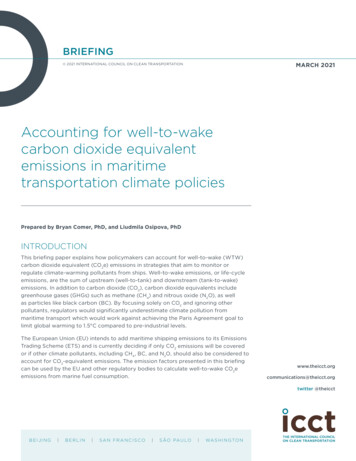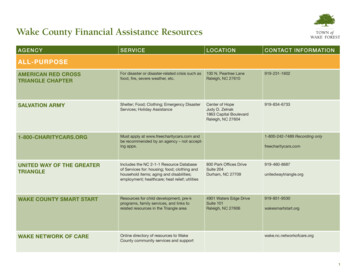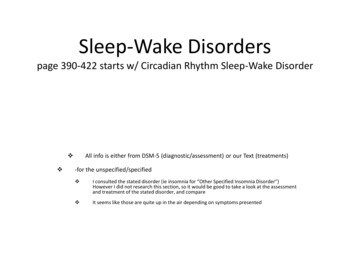
Transcription
BRIEFINGMARCH 2021 2021 INTERNATIONAL COUNCIL ON CLEAN TRANSPORTATIONAccounting for well-to-wakecarbon dioxide equivalentemissions in maritimetransportation climate policiesPrepared by Bryan Comer, PhD, and Liudmila Osipova, PhDINTRODUCTIONThis briefing paper explains how policymakers can account for well-to-wake (WTW)carbon dioxide equivalent (CO2e) emissions in strategies that aim to monitor orregulate climate-warming pollutants from ships. Well-to-wake emissions, or life-cycleemissions, are the sum of upstream (well-to-tank) and downstream (tank-to-wake)emissions. In addition to carbon dioxide (CO2), carbon dioxide equivalents includegreenhouse gases (GHGs) such as methane (CH4) and nitrous oxide (N2O), as wellas particles like black carbon (BC). By focusing solely on CO2 and ignoring otherpollutants, regulators would significantly underestimate climate pollution frommaritime transport which would work against achieving the Paris Agreement goal tolimit global warming to 1.5 C compared to pre-industrial levels.The European Union (EU) intends to add maritime shipping emissions to its EmissionsTrading Scheme (ETS) and is currently deciding if only CO2 emissions will be coveredor if other climate pollutants, including CH4, BC, and N2O, should also be considered toaccount for CO2-equivalent emissions. The emission factors presented in this briefingcan be used by the EU and other regulatory bodies to calculate well-to-wake CO2eemissions from marine fuel orgtwitter @theicctBEIJING BERLIN SAN FRANCISCO S Ã O PA U LO WA S H I N G TO N
APPROACH FOR CALCULATING WELL-TO-WAKEEMISSIONS BASED ON FUEL CONSUMPTIONWell-to-wake CO2e emissions (CO2eWTW) account for the amount of climate pollutantsemitted upstream well-to-tank (WTT) and downstream tank-to-wake (TTW). Thisbriefing reports CO2eWTW based on both 100-year and 20-year global warmingpotentials. As upstream and downstream pollutants vary according to the type offuel and engines that are used, the analysis determines the emissions factors for fourdifferent marine fuels and multiple engine types. Fuels include heavy fuel oil (HFO),very-low sulfur fuel oil (VLSFO), marine gas oil (MGO), and liquefied natural gas (LNG).Engine types include slow speed diesel (SSD); medium speed diesel (MSD); two-stroke,slow-speed, Otto-cycle, dual fuel LNG (LNG-Otto-SS); four-stroke, medium-speed,Otto-cycle, dual fuel LNG (LNG-Otto MS); lean-burn spark ignition LNG (LBSI); twostroke, slow-speed, Diesel-cycle LNG (LNG-Diesel), and steam turbines.The global warming potentials listed in Table 1 represent the relative amount of heateach pollutant traps compared with the heat trapped by the same amount of CO2 overa given period after emission.Table 1. Global warming potentials for climate pollutants.Pollutant100-year20-yearCO211CH43687N 2O298268BC9003200SourceReference levelIPCC AR5 Table 8.7, with climate-carbon feedbacks, 1to GWP20 and 2 for GWP100 for fossil methane, perfootnote in Table 8.7IPCC AR5 Table 8.7, with climate-carbon feedbacksBond et al. and Comer et al.As shown in Table 1, CO2 is used as the reference and has a global warming potentialequal to one. For CH4 and N2O, values were obtained from the IntergovernmentalPanel on Climate Change (IPCC) Fifth Assessment Report (AR5).1 For BC, values wereobtained from Bond et al. 2 and Comer, Olmer, Mao, Roy, and Rutherford. 3A ship’s CO2eWTW can be calculated based on the mass of fuel the ship consumed anda well-to-wake carbon dioxide equivalent factor (CEF WTW) for that fuel, as shown inEquation 1. Although the equation determines grams of CO2e, the same equation canbe used with any other unit of mass. For example, if one gram of heavy fuel oil resultsin 4.5 grams of CO2eWTW, one tonne will emit 4.5 tonnes of CO2eWTW. For the EU ETSand other policies based on the fuel consumption of large ships, tonnes will be a moreappropriate unit.1Rajendra K. Pachauri and Leo A. Meyer, Climate Change 2014: Synthesis Report (Contribution of WorkingGroups I, II and III to the Fifth Assessment Report of the Intergovernmental Panel on Climate Change (IPCC:Geneva, Switzerland, 2014), https://www.ipcc.ch/report/ar5/syr/.2Bond, T. C., et al., Bounding the role of black carbon in the climate system: A scientific assessment, J. Geophys.Res. Atmos., 118 (2013) 5380– 5552, https://doi.org/10.1002/jgrd.50171.3Bryan Comer, Naya Olmer, Xiaoli Mao, Biswajoy Roy, and Dan Rutherford, Black carbon emissions and fueluse in global shipping, 2015, (ICCT: Washington, DC, 2017), ions-global-shipping-2015.2ICCT BRIEFING ACCOUNTING FOR WELL-TO-WAKE CARBON DIOXIDE EQUIVALENT EMISSIONS
Equation 1CO2eWTW FC CEF WTWCO2eWTW well-to-wake emissions, in gCO2eFC fuel consumption, in gCEF WTW well-to-wake carbon dioxide equivalent factor for that fuel, in gCO2e/g fuelFuel consumption is reported by ship owners or operators. In the case of the EU ETS,fuel consumption will be based on EU Monitoring Reporting and Verification data. TheCEF WTW is calculated based on WTT emissions associated with extracting, processing,and transporting the fuel and TTW emissions associated with using the fuel on boardthe ship. The TTW emissions include combustion and non-combustion emissions, suchas methane slip from marine engines that use LNG. Equation 2 shows that CEF WTW isthe sum of the WTT and TTW carbon dioxide equivalent factors, labeled CEF WTT andCEF TTW, respectively.Equation 2CEF WTW CEF WTT CEF TTWCEF WTW well-to-wake carbon dioxide equivalent factor, in gCO2e/g fuelCEF WTT well-to-tank carbon dioxide equivalent factor, in gCO2e/g fuelCEF TTW tank-to-wake carbon dioxide equivalent factor, in gCO2e/g fuelAs shown in Equation 3, CEFWTT is calculated based on the emission factors for eachclimate pollutant (EFWTT p) and the associated 100-year or 20-year global warmingpotential for each pollutant (GWPp). The CEF TTW is calculated in the same manner, perEquation 4.Equation 3CEF WTT Σ(EFWTTp GWPp)CEF WTT well-to-tank carbon dioxide equivalent factor, in gCO2e/g fuelEF WTTp well-to-tank emission factor of pollutant p, in g/g fuelGWPp the 100-year or 20-year GWP of pollutant p,Equation 4CEF TTW Σ(EFTTWp GWPp)CEF TTW tank-to-wake carbon dioxide equivalent factor, in gCO2e/g fuelEF TTWp tank-to-wake emission factor of pollutant p, in g/g fuelGWPp the 100-year or 20-year GWP of pollutant pThe EF WTT and EF TTW include CO2, CH4, N2O, and BC. Table 2 shows EF WTT by fuel typeand engine type for each pollutant, as well as CEF WTT, calculated in accordance withEquation 3 and the 100-year or 20-year global warming potentials listed in Table 1.3ICCT BRIEFING ACCOUNTING FOR WELL-TO-WAKE CARBON DIOXIDE EQUIVALENT EMISSIONS
(Note that WTT BC emission factors have not yet been established but could beadded in the future.) Table 3 shows EF TTW for each pollutant by fuel type and enginetype, as well as CEF TTW, calculated in accordance with Equation 4 and the GWPs inTable 1. Summing them together, Table 4 shows well-to-wake emission factors foreach pollutant and CEF WTW. The following two sub-sections explain in detail how wedetermined EF WTT and EF TTW.Table 2. Well-to-tank emission factors for each pollutant (EF WTT) and associated carbon dioxide equivalent factors (CEF WTT).Well-to-tank (g/g fuel)EFWTTFuel typeaHFOVLSFOMGOLNGEngine .018100.000011.1842.107LNG-Otto-MS 0.53000.018100.000011.1842.107LNG-Otto-SS 0011.1842.107LBSI crankcase0.53000.018100.000011.1842.107Steam Turbine0.53000.018100.000011.1842.107UnknownaWTT emission factors for black carbon are yet to be established but could be added later. If so, CO2e100 and CO2e20 values will increase based onthe BC emission factor and global warming potential.a4ICCT BRIEFING ACCOUNTING FOR WELL-TO-WAKE CARBON DIOXIDE EQUIVALENT EMISSIONS
Table 3. Tank-to-wake emission factors for each pollutant (EF TTW) and associated carbon dioxide equivalent factors (CEF TTW).Tank-to-wake (g/g fuel)EFTTWFuel typeHFOVLSFOMGOLNGEngine 000024.0755.916LNG-Otto-MS -SS 0.026280.000130.000023.7525.135LBSI crankcase2.7500.032690.000130.000023.9835.693Steam Turbine2.7500.000140.000070.000022.7942.845Table 4. Well-to-wake emission factors for each pollutant (EF WTW) and associated carbon dioxide equivalent factors (CEF WTW).Well-to-wake (g/g fuel)EFWTWFuel typeHFOVLSFOMGOLNG5Engine 000025.2598.023LNG-Otto-MS -SS 0.044380.000140.000024.9367.242LBSI crankcase3.2800.050790.000140.000025.1677.799Steam Turbine3.2800.018240.000080.000023.9784.952ICCT BRIEFING ACCOUNTING FOR WELL-TO-WAKE CARBON DIOXIDE EQUIVALENT EMISSIONS
DETERMINING WELL-TO-TANK EMISSION FACTORS FOR EACHPOLLUTANTThe WTT emission factors in Table 2 are obtained by multiplying the upstream energybased emission factors for marine fuels in in Table 5 (g pollutant/megajoule) by the fuelenergy content assumption in Table 6 (MJ/g fuel). The energy content assumptions forHFO, MGO, and LNG are consistent with the Fourth IMO GHG Study.4 Assumptions forVLSFO, which was not assessed in the Fourth IMO GHG Study, are taken from aprevious analysis.5 The upstream CH4 emissions for liquified natural gas in Table 5 (0.38gCH4/MJ) are consistent with the findings in a previous study which finds thatupstream methane leakage from liquefied natural gas production is higher than the0.30 gCH4/MJ assumed by the U.S. Environmental Protection Agency.6Table 5. Well-to-tank emissions for marine fuels 811.04Table 6. Energy content of marine fuelsFuelHFOEnergy content (MJ/g G TANK-TO-WAKE EMISSION FACTORS FOR EACHPOLLUTANTThe TTW emission factors for each pollutant are shown in Table 3, and CO2 isconsistent with the carbon dioxide factors used in the Fourth IMO GHG Study7 for HFO,MGO, and LNG and Comer et al. 8 for VLSFO, as shown in Table 7.Table 7. Carbon factors for marine fuels.FuelCarbon factor (gCO2/g fuel)HFO3.114MGO3.206VLSFO3.188LNG2.7504Jasper Faber, Shinichi Hanayama, Shuang Zhang, Paula Pereda, Bryan Comer, Elena Hauerhof,., and Hui Xing“Fourth IMO greenhouse gas study,” (International Maritime Organization, 2020), https://docs.imo.org/.5Bryan Comer, Elise Georgeff, and Liudmila Osipova, Air emissions and water pollution discharges from ships withscrubbers, ICCT: Washington, DC, 2020), on-scrubbers-2020.6Nikita Pavlenko, Bryan Comer, Yuanrong Zhou, Nigel Clark, and Dan Rutherford, The climate implications ofusing LNG as a marine fuel, (ICCT: Washington, DC, 2020) G-marine-fuel-2020.7Faber et al., “Fourth IMO greenhouse gas study.”8Comer, Georgeff, and Osipova, Air emissions and water pollution discharges from ships with scrubbers.6ICCT BRIEFING ACCOUNTING FOR WELL-TO-WAKE CARBON DIOXIDE EQUIVALENT EMISSIONS
Black carbon TTW emission factors are consistent with those used in the Faber et al.9and Comer et al.10 We assume that the BC emission factors for VLSFO are the same asfor HFO. Black carbon emission factors are a function of fuel type, engine type, andengine load. The BC TTW emission factors for HFO, VLSFO, and MGO in Table 3 assumethat ships operate at 50% load, corresponding to the gray shaded row in Table 8, and aredivided by 1000 to convert from units of gBC/kg fuel to gBC/g fuel. Emission factors forLNG are the same as those in Faber et al. and Comer et al., as shown in Table 9.11Table 8. Black carbon emission factors for oil-based fuels (g/kg fuel)HFO or VLSFOMGOEngine 150.250.030.12Table 9. Black carbon emission factors for LNG (g/kg fuel)Engine typeBC (g/kg LNG)LNG-Otto-MS, LNG-Otto-SS, LBSI0.02LNG-Diesel0.01Steam Turbine0.02Methane TTW emission factors are consistent with those use in the Fourth IMO GHGStudy.12 To calculate CH4 TTW emissions factors, we divide the CH4 energy-basedemission factors used in Faber et al.,13 which can be found in Table 10 and are in unitsof gCH4/kWh, by the specific fuel consumption (SFC) of each fuel-engine pair in Table11, which are in units of g fuel/kWh. This results in TTW CH4 emission factors in units ofgCH4/g fuel. The SFC assumptions reflect 2001 and newer model year engines and are9Faber et al., “Fourth IMO greenhouse gas study.”10 Bryan Comer, Naya Olmer, Xiaoli Mao, Biswajoy Roy, and Dan Rutherford, Black carbon emissions and fueluse in global shipping, 2015. (ICCT: Washington, DC, 2017) ions-global-shipping-2015.11Faber et al., “Fourth IMO greenhouse gas study;” Comer, Georgeff, and Osipova, Air emissions and waterpollution discharges from ships with scrubbers.12 Faber et al., “Fourth IMO greenhouse gas study.”13 Faber et al., “Fourth IMO greenhouse gas study.”7ICCT BRIEFING ACCOUNTING FOR WELL-TO-WAKE CARBON DIOXIDE EQUIVALENT EMISSIONS
taken from the Fourth IMO GHG Study.14 The Fourth IMO GHG Study’s LNG engine SFCassumptions are consistent with Pavlenko et al., which reflects modern LNG enginesbuilt in the last several years.15 We assume that ships using VLSFO emit the sameamount of CH4 as those using HFO. Some ships using low-pressure injection engines,including LNG-Otto and LBSI may have open crankcases; if so, Pavlenko et al. estimatethat there could be an additional 1 gCH4/kWh escaping unburned from the crankcase.16Therefore, in Table 3, we include rows that show the impact on CH4 and CO2e fromthese additional crankcase emissions for LNG-Otto and LBSI engines in Table 10.Table 10. Methane emission factors (g/kWh)Engine typeFuel typeMethane (g/kWh)HFO, VLSFO, selLNG0.2LBSILNG4.1aHFO, VLSFO, MGO0.002LNG0.04SSD or MSDSteam Turbinea This table shows methane emission factors used in the Fourth IMO GHG Study; however, low-pressureinjection engines, such as LNG-Otto-MS, LNG-Otto-SS, and LBSI, may have open crankcases, which couldemit an additional 1.0 gCH4/kWh.Table 11. Specific fuel consumption (g/kWh) for marine engines.Fuel typeEngine typeSpecific fuel consumption(g LBSI156Steam Turbine285Nitrous oxide TTW emission factors are consistent with those use in the Fourth IMOGHG Study.17 To calculate N2O TTW emissions factors, we divide the N2O energy-basedemission factors used in Faber et al.,18 which can be found in Table 12 and are in units ofgN2O/kWh, by the SFC of each fuel-engine pair in Table 11, which are in units of g fuel/14 Faber et al., “Fourth IMO greenhouse gas study.”15 Pavlenko et al., The climate implications of using LNG as a marine fuel.16 Pavlenko, et al., The climate implications of using LNG as a marine fuel.17 Faber et al., “Fourth IMO greenhouse gas study.”18 Faber et al., “Fourth IMO greenhouse gas study.”8ICCT BRIEFING ACCOUNTING FOR WELL-TO-WAKE CARBON DIOXIDE EQUIVALENT EMISSIONS
kWh. This results in TTW N2O emission factors in units of gN2O/g fuel. We assume thatships using VLSFO emit the same amount of N2O as those using HFO.Table 12. Nitrous oxide emission factors (g/kWh)EngineFuelN2O (g/kWh)SSD or MSDHFO, VLSFO, MGO0.03Steam TurbineHFO, VLSFO, MGO0.04LNG-Otto-MS, LNG-Otto-SS, LBSILNG0.02LNG-DieselLNG0.03Steam TurbineLNG0.02RESULTSTable 13 presents WTW emission factors for fossil marine fuels developed according tothe methodology described in this briefing. These WTW emission factors include bothupstream well-to-tank (WTT) and downstream tank-to-wake (TTW) emission factors.In Table 13, CO2 accounts for only carbon dioxide emissions, whereas CO2e100 andCO2e20 account for emissions of other climate pollutants based on their 100-yearor 20-year global warming potential. Comparing the three metrics, one can seethat focusing solely on CO2 and ignoring other climate pollutants can significantlyunderestimate climate pollution from maritime transport. We suggest policymakersconsider not only CO2e100 but also CO2e20 for policies intended to be aligned withthe Paris Agreement. In addition to reducing CO2 emissions, reducing pollutants withlarge 20-year global warming potential, such as CH4, BC, and N2O, can help preventadditional near-term warming.Table 13. Well-to-wake carbon dioxide and carbon dioxide equivalent factors (CEF WTW) for fossilmarine fuels.Well-to-wake (g/g fuel)Fuel typeHFOVLSFOMGOLNG9Engine .023LNG-Otto-MS LNG-Otto-SS BSI3.2804.9367.242LBSI crankcase3.2805.1677.799Steam Turbine3.2803.9784.952ICCT BRIEFING ACCOUNTING FOR WELL-TO-WAKE CARBON DIOXIDE EQUIVALENT EMISSIONS
DISCUSSIONTo give an example of why it is important to consider not only CO2 but also CO2e100and CO2e20, consider the figures below. Each figure applies Equation 1, and fuelconsumption (FC) is assumed to be 1000 tonnes. Figure 1 shows the CO2eWTWemissions of consuming 1,000 tonnes of LNG in the engine with the highest WTWemissions (LNG-Otto-MS crankcase) and the LNG engine with the lowest WTWemissions (LNG-Diesel). The exercise is repeated for SSD and MSD engines running onVLSFO (Figure 2) and MGO (Figure 3). Notice that estimates of WTW climate pollutioncan more than double for LNG engines that have high methane slip when evaluated onCO2e20 compared with CO2 (left side of Figure 1). Figure 2 and Figure 3 show that therelative contribution of black carbon emissions to WTW emissions depends strongly onwhether it is evaluated using 100-year or 20-year global warming potential. When BCis accounted for, using MGO results in lower WTW emissions than VLSFO.90008580CO2CH4N2OBC8000Tonnes of climate CO2e100 CO2e20LNG-Otto-MS ( crankcase)CO2CO2e100 CO2e20LNG-DieselFigure 1. Well-to-wake emissions of consuming 1000 tonnes of liquefied natural gas in two engines.10ICCT BRIEFING ACCOUNTING FOR WELL-TO-WAKE CARBON DIOXIDE EQUIVALENT EMISSIONS
6000CO2CH4N2O5000Tonnes of climate 0CO2CO2e100 CO2e20CO2SSDCO2e100 CO2e20MSDFigure 2. Well-to-wake emissions of consuming 1000 tonnes of VLSFO in two engines.6000CO2CH4N2OBC5068Tonnes of climate CO2e100 CO2e20SSDCO2CO2e100 CO2e20MSDFigure 3. Well-to-wake emissions of consuming 1000 tonnes of MGO in two engines.11ICCT BRIEFING ACCOUNTING FOR WELL-TO-WAKE CARBON DIOXIDE EQUIVALENT EMISSIONS
CONCLUSIONSThis briefing paper outlines a methodology for calculating well-to-wake carbon dioxideequivalent emissions from four fossil marine fuels: heavy fuel oil, very low sulfur fuel oil,marine gas oil, and liquefied natural gas. Well-to-wake emission factors for these fuelsare presented in Table 13. While the EU Emissions Trading Scheme presents the mostimmediate opportunity to apply this methodology, it can also be applied to policiesbeing developed at the International Maritime Organization and in other regions andcountries that aim to reduce shipping’s climate impacts.The WTW carbon dioxide equivalent factors developed in this briefing cover existingmarine fuels but could be expanded to new fuels including hydrogen and ammonia,two fuels where the WTT component is particularly important when evaluating theirlife-cycle climate consequences. No matter which fuel is used, WTT emissions willdepend on the feedstock and production pathway. In addition, the TTW emissionswill depend on whether the fuel is used in a fuel cell, combusted in an engine, or usedin some other way. As new fuels and energy sources for shipping are researched anddeveloped, it will be important to develop WTW emission factors that encompass theirfull life-cycle emissions in order to accurately judge their climate credentials.12ICCT BRIEFING ACCOUNTING FOR WELL-TO-WAKE CARBON DIOXIDE EQUIVALENT EMISSIONS
emissions, are the sum of upstream (well-to-tank) and downstream (tank-to-wake) emissions. In addition to carbon dioxide (CO 2), carbon dioxide equivalents include greenhouse gases (GHGs) such as methane (CH 4) and nitrous oxide (N 2 O), as well as particles like black carbon (BC). By focusing solely on CO 2 and ignoring other











